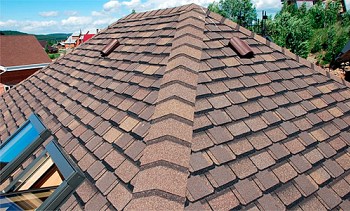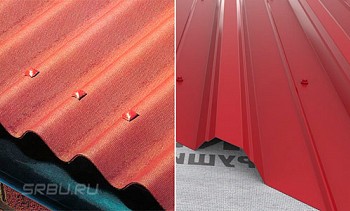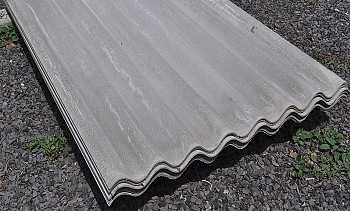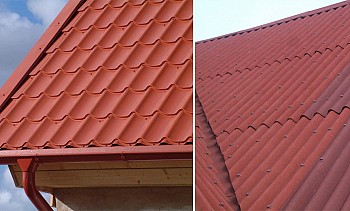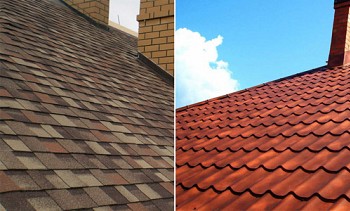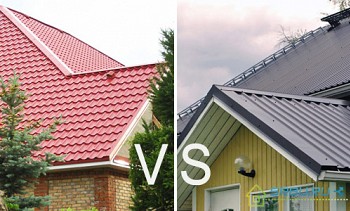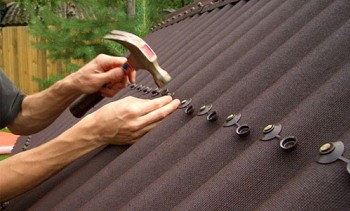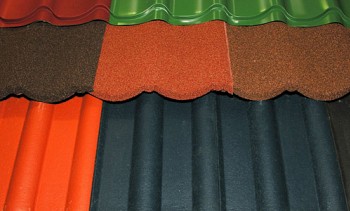House without the roof - This is not a house at all. And for its coating, various types of roofs are used: soft and hard, rolled and piece, flat and profile. Some of them are better suited for suburban mansions and cottages, others - for urban houses, and others - for farm buildings. To make a specific choice, you must have an idea of the properties of each of the roofing materials.
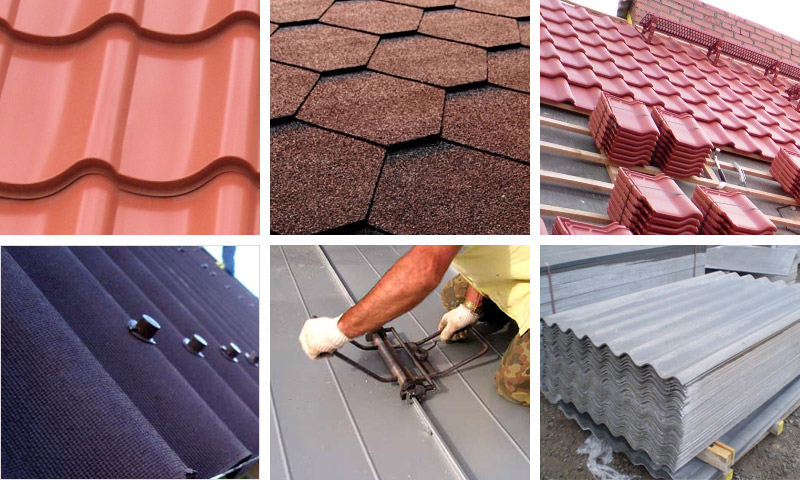
Content:
- Roofing sheet - briefly about all its varieties
- Metal - durable, beautiful, but noisy
- Roofing decking - an inexpensive relative of metal
- Ondulin - environmentally friendly, water resistant, but combustible
- Slate - cheap, durable, but contains asbestos
- Steel rebate roof - flexible, smooth and shiny, but cold
- Folded roof made of copper and aluminum - elegant and very reliable, but expensive
- Soft roof and its varieties
- Flexible tile - fiberglass plus bitumen
- Roll-up roof
- Flat Membrane Roofing
- Piece roofing materials
- Ceramic tile - very beautiful, but heavy and expensive
- Sand and cement tiles - lighter than clay, but not so long
- Slate roofing - a rare elite coating
- Self-leveling roof - applied directly to concrete
Roofing sheet - briefly about all its varieties
Metal - durable, beautiful, but noisy
This roof covering is sometimes indistinguishable from expensive ceramic tiles. The metal tile contains a cold-rolled steel sheet (from 0.4 mm to 0.5 mm thick) with a zinc coating, which for reliability is coated with one of the types of polymers. A protective varnish is applied on top, and inside there are several more layers. This, in particular, is a primer, as well as a passivating aluminum coating. The finished sheet is very light - from 3 to 5 kg 1 m2.

Installation.During installation, the lower permissible roof slope is - 150 (no upper limit). With small deviations, up to 200, you need to tightly isolate the joints between the sheets. To fix the roof to the crate, self-tapping screws with rubber gaskets are used. The overlap along the length of the sheets can be from 45 mm. up to 150 mm. depending on the type of profile of the metal tile.

An example of a battens for installation of a metal tile.
Application area metal tiles are very large. It is used as a roof for roofs of private houses, buildings in production, as a roof for garages, stalls. Often a flat roof is framed by a metal tile, laying it under a slope. The result is a false roof.
Durability This material is quite satisfied with the buyer. From 30 to 50 years, nothing will happen with such a roof. If you take into account that for one square meter of metal you need to pay from $ 7 to $ 15, then this is a reasonable investment of money. Now specifically about the good and the bad.
+ The advantages of metal:
- The metal tile is quickly and easily attached;
- it easily withstands shock and load;
- light weight (you can lay the roof alone);
- transportation and loading do not require careful handling;
- The price is not very high.
- Cons of metal:
- Uneconomical (waste makes up a considerable percentage);
- noise (any sound is well transmitted through metal).

Separately, it is necessary to highlight the composite metal tile. Instead of a polymer coating, stone crumb is applied in a special way on the surface as a protective layer.
Roofing decking - an inexpensive relative of metal
Profiled flooring (corrugated sheet, profiled sheet), like the previous material, is made of cold rolled steel with hot galvanization. Sometimes for him, the metal is taken thicker than for metal. Sheets can have both a rectangular and a wavy profile.From all sides they are covered with aluzinc or zinc layer. There is an additional polymer protection on top. The profile may take the form of a trapezoid, wave, rectangle. Roofing is a corrugated board of the following brands: C8, C21, HC35, C44, H57, H60.

Installation. The roof slope should be no less than 100 (maximum is not limited). During installation, an overlap of the order of 20 cm is made, which, with a slight slope of the roof, is filled with sealant. Fastening is done with self-tapping screws, which go from 6 to 8 pieces per square meter. Sometimes the professional sheet is laid directly on the old rolled roof.

An example of a metal crate for corrugated board, which is used when installing the roof for utility and industrial premises.
Application area. This type of roofing is often used for utility buildings, such as sheds and garages. They also cover the roofs of industrial enterprises, shops, car washes.
Durability and price. Serves corrugated board up to 50 years. Its square meter costs about $ 10 or more.
+ Pros of roofing sheeting:
- Installation of a professional sheet is simple;
- the bending strength of the material is very high;
- the service life is long;
- The price is reasonably reasonable.
- Cons of roofing sheeting:
- Decking refers to the "noisy" types of roofing, requiring mandatory soundproofing.
Ondulin - environmentally friendly, water resistant, but combustible
This coating attracts with its naturalness and price. It consists of thin cellulose fibers impregnated with bitumen with polymer additives. It is called not only ondulin, but also euro slate, as well as aqualin. Painted with heat-resistant polymer paint (in one or two layers), it looks very good. Sheets weighing 6.5 kg are made in the form of waves with a height of 3.6 cm. Their length is 2 m, width - 0.96 m.
- See material for more details:Ondulin sheet dimensions and its overall characteristics
- More information: Ondulin pros, cons and characteristics of roofing

Installation. The minimum angle of inclination of the roof for the use of ondulin is 60. If he is not more than 100, the crate is made continuous, making a longitudinal overlap of at least 30 cm. Slope from 10 to 150 assumes a lathing from a bar with a step of 45 cm. For corners more than 150 a stripping step of about 60 cm is sufficient. Special nails are used for fastening.
Application area. Ondulin is often used to cover canopies, baths and garages. It is good for complex roofs, as it bends easily. It is convenient to renovate the old roof (for example, from slate) with this coating, while giving it a new life.

Durability and price. The service life of water resistance is 40 years. Paints, however, fade earlier. The price of coverage is about $ 5 per sheet.
+ Pros of Ondulin:
- Excellent water resistance;
- hygiene and environmental friendliness;
- resistance to chemical aggression;
- the ability to withstand loads of up to 960 kg per square meter (with full compliance with the installation rules);
- the lightest weight, ease of transportation and installation;
- ease of cutting (a simple hacksaw is suitable for working with wood);
- absolute noiselessness;
- budget price.
- Cons Ondulin:
- flammability (temperature limit 110 degrees);
- paint fades on the surface;
- after 2-3 years moss grows in dimly lit places;
- you can’t climb into the ondulin roof in the heat - it softens and smells strongly of bitumen.
- See material for more details:Pros, cons and characteristics of Ondulin

In addition to Ondulin, there is Onduville, this is a kind of relative of Ondulin. Onduvilla has a more presentable appearance and other sheet sizes. As you can see in the photo, her sheets are much narrower than that of Ondulin.
Slate - cheap, durable, but contains asbestos
Of all types of roofing materials, this is perhaps the most affordable. It contains 85 percent of Portland cement, the rest is asbestos. A standard wavy slate sheet weighs from 10 to 15 kg. Its length is 1750 mm, its width is from 980 to 1130 mm. It can be 6, 7 and 8 wave.
- For more information about sizes, see the article:Sizes of various types of slate

Installation. Slate can be placed with a slope of the roof from 12 to 600. During installation, overlapping of sheets in one or two waves is necessary. Lathing of square bars with a cross section of 5 centimeters and a pitch of 50 to 55 cm is enough. In the case of slate with a reinforced profile, the bars are needed thicker (with a cross section of 7.5 cm), and the step of the crate is larger (75-80 cm). Under the slate you need a lining of roofing material or glassine. A soft pad is also placed under each nail.
Application area. Slate, toilets and other household buildings are usually covered with slate. Private houses cover them only when the owners are very limited in means.
Durability and price. The life of the slate is from 30 to 40 years. A square meter costs about $ 2-3.
+ Pros of slate:
- greater bending and impact strength;
- ease of processing - slate is extremely easy to cut ordinary grinder;
- low cost;
- inability to burn.
- Cons of slate:
- Asbestos contained in slate is not safe for humans;
- slate is fragile;
- Due to the high hygroscopicity, the material accumulates moisture, which leads to fading and the formation of moss.
Steel rebate roof - flexible, smooth and shiny, but cold
Flat steel sheets of which this material is made do not allow moisture to linger on the roof. Steel is used with or without zinc coating. A polymer protective layer may be provided. This roof got its name because of a special connection of sheets - a fold. It can be recumbent or upright, double or single. The sheets are fastened along the length with each other with folds of the standing type, and in width - with the folds.

Installation. During installation, you must first connect the sheets with folds in the so-called "picture" with curved side edges, focusing on the length of the ramp. Do it downstairs at the construction site. Then, already on the roof, the side edges are connected by a standing fold. Pictures are attached to the crate with narrow strips of galvanized steel - clamps.
The roofing slope for laying folded sheets must be at least 140. In addition to a crate of bars with a five-centimeter square section and a pitch of 20 to 40 cm, a film against condensation is provided. Slope 7 to 140 makes the base solid.

Joining of folded roof sheets

Types of seam joints used for installation of seam roofs.
Application area. It has long been used such a roof for the roofs of cathedrals and manor houses. They also cover industrial facilities.
Durability and price. This coating serves from 25 to 30 years. Its price is from 5 to 7 $ per square meter.
+ Advantages of steel seam roof:
- Inability of the roof to burn;
- nice appearance;
- high flexibility to cover roofs of various complex shapes;
- light weight (from 4 to 5 kg) does not require reinforced rafters;
- resistance to subzero temperatures.
- Cons of steel seam roof:
- Impacts can harm the roof;
- without insulation, it is better not to use flange sheets (it will be cold in the house);
- there are few masters working with such a coating;
- static electricity can build up on the fold roof;
- high roof noise.
Folded roof made of copper and aluminum - elegant and very reliable, but expensive
These roof coverings are good in that they are absolutely not affected by the main enemy of the metal roof - corrosion. Copper sheets with a thickness of at least 0.3 mm are made 1.1 m long and 0.7 m wide. A square meter of such a roof weighs from 5 to 10 kg (aluminum - 2-5 kg).

Installation. The slope of the roof must be at least 150. Installation is the same as in the case of steel coating. Depending on the material of the roof, only fasteners are either copper or aluminum, but not steel. Otherwise, corrosion will quickly “eat” the roof.
Durability and price. The film formed after some time on the roof surface of copper or aluminum, does not allow them to collapse. Therefore, folded roofs from all types of roofing are the most durable. Copper - up to hundreds of years, aluminum - up to 80 years. However, the prices for such a pleasure are fair.A square meter of copper seam cover will lighten your wallet in the amount of $ 30-40 (and sometimes more).
+ Pluses of a seamed copper and aluminum roof:
- Almost no need for care (enough cleaning once every six months)
- incombustibility;
- safety and environmental friendliness;
- corrosion and acid rain will not spoil the roof;
- great view.
- Cons of seam copper and aluminum roofing:
- very high price.
Soft roof and its varieties
Flexible tile - fiberglass plus bitumen
This coating is also called shingle, shiglas or just a soft roof. For its manufacture, the base of fiberglass is impregnated with bitumen with a modifier, and stone crumb (basalt or slate) is applied on top. It also gives the roof protection from ultraviolet radiation, color and volumetric pattern. A self-adhesive layer of bitumen with polymer is applied from the inside.

Installation. The minimum slope of the roof for its installation is - 110. This coating requires a continuous crate made of waterproof plywood or OSB boards. At tilt angles up to 180 it is better to lay an additional layer of roll coating.

An example of a base for laying flexible tiles.
Application area. This roof is good to use on roofs of complex shape, as well as in the presence of an attic.
Durability and price. Its service life is up to 70 years. Its inexpensive brands are $ 5-10 per square meter.
+ Advantages of a flexible roof:
- Noiselessness;
- the ability to retain snow on a rough surface;
- Beautiful design;
- lack of corrosion and condensate;
- flexibility.
- reasonable price.
- Cons of a flexible roof:
- fragility in frost;
- melting and smell in the heat;
- flammability.
Roll-up roof
It is also called hydroisol or glassisol. However, some manufacturers give their material their names, but the contents of this do not change dramatically. This coating is made on the basis of fiberglass, fiberglass or polyester. Polyester is durable, but expensive, fiberglass is also good, but fiberglass does not shine with quality. The base is poured with oxidized bitumen, in which one of the types of modifiers is added for elasticity and durability. This is either SBS (styrene-butadiene-styrene), or APPP (atactic polypropylene). Then comes a layer of polymer and a sprinkling of sand, fine slate or mica.

Installation. The roof slope at which this material can be used must be at least 110. Insulation is placed on a solid foundation (made of wood, metal, concrete or flat slate), and waterproofing on top. Then apply a primer or gasoline dissolved in bitumen. Using a gas burner, a roofing carpet is glued, starting from the bottom. End and lateral overlaps do not less than 10 cm.

Flat roof sheltered by a roll-up roof.
Application area. Use this coating on the flat roofs of multi-storey buildings - residential and industrial. In a private house, it can be waterproofed.
Durability and price. This roof serves up to 50 years. Price per square meter - no more than $ 2.
+ Advantages of a roll-up roof:
- Roofing almost does not require care;
- protection against fire, moisture and noise;
- environmental friendliness and harmlessness;
- low price;
- light weight.
- Cons of a roll-up roof:
- Store rolls only in a standing position, away from heating appliances.
Flat Membrane Roofing
Membranes have a thickness of 0.8 to 2 mm. They can be of three types: PVC, EPDM and TPO. PVC membranes are not environmentally friendly, but they can protect against ultraviolet radiation and fire. EDPM membranes made of artificial rubber reinforced with a polyester mesh are durable and harmless to humans. TPO membranes consist of thermoplastic olefins with mesh reinforcement. They are also environmentally friendly.
Installation. The slope of the roof can be any, since the membranes are elastic. They are attached to the base (solid) in various ways, the best of which is hot air welding. On the roof with a large slope, they attach the membrane mechanically - with special fasteners. If the slope is more than 100, you can apply the ballast method, filling the roof with gravel. On complex roofs, membranes are glued.
Application area. This coating is used on fairly flat roofs of residential or public buildings.
Durability. The service life of the roof is up to 50 years. PVC furniture costs from 5 to 8 $ per square meter.
+ The advantages of a membrane roof:
- Membranes are wide, allowing you to cover any roof;
- additional protection against moisture is not required - the roof is already waterproof;
- the roof can be covered at any time of the year;
- installation occurs in a short time, repairs are extremely rare;
- puncture resistance is very high.
- Cons of the membrane roof:
- It is necessary to carefully prepare the base, removing all the pebbles;
- solvents and organic oils can ruin the roof.
Piece roofing materials
Ceramic tile - very beautiful, but heavy and expensive
This roofing material is one of the oldest types of roofing for a roof, along with wooden shingles and slate. For the manufacture of tiles, clay is fired at a thousand-degree temperature, after which it becomes solid and durable, and the color becomes brown with a reddish tint. Some types of tiles are glazed before firing to increase water-repellent properties. Finished tiles (weighing 2 kg or more) have a length and width of 30 cm.

There are several types of clay tiles.
Here are the main ones:
- Tile flat tile;
- Tile grooved tiles;
- stamped mortise tiles;
- ceramic ordinary tiles;
- single wave tile;
- two-wave tile;
- grooved tiles.
Installation. It is preferable to build a tile roof with a roof slope of at least 25 and not more than 600. If he is less than 220then it is imperative to provide a waterproofing layer and good ventilation. A slope exceeding 600will require more screws or nails for fastening. Separate elements (they are placed with an overlap of the upper tile on the lower) are connected by special locks. The finished roof looks like solid scales, so that it has less opportunity to leak. The tile is attached to the crate with nails through special holes.

Application area. Use this roof to cover roofs in homes from bricks, wood, stone. The number of floors does not matter.
Durability and price. The durability of such a roof is impressive - it can stand without repair for 150 years. However, not everyone can afford such a luxurious coating. After all, its price per square meter ranges from $ 20 to $ 50.
+ The advantages of ceramic tiles:
- Economical operation - prevention and cleaning of gutters with valleys is needed only once a year;
- good insulation - rain will not interfere with sleep under a tiled roof;
- incombustibility;
- resistance to corrosion;
- resistance to frost (at least 1000 freezing cycles);
- esthetics, variety of tones and profiles;
- the roof of the tiles is porous, it is able to "breathe" by evaporating water.
- Cons of ceramic tiles:
- The weight of the roof is considerable - we need thicker or more frequent rafters;
- the tile is fragile;
- it is problematic to cover a complex roof with it - additional fasteners, lathing, insulation will be required;
- high price.
Sand and cement tiles - lighter than clay, but not so long
This piece coating is made of a solution of sand with cement, which is not fired, but pressed under pressure. The dye is iron oxides, making this tile look like ceramic. Glaze is either applied on top, or there is no coating. The surface is made smooth or with a convex profile pattern. This roof weighs from 35 to 40 kg (one square meter).

Installation. Optimum slope for installation - from 20 to 600. Fastening to the crate goes in rows, through the holes on the tile. In this case, a “dressing” is made, equal to one second of the width of the tile. This is the name of the shift of the series relative to the neighboring one. Rafters are taken with a cross section of 5 by 15 cm, and the distance between them is from 60 to 90 cm. In addition to the battens, a layer of waterproofing is required.
Application area. This roof, like the previous one, can be used in houses of various materials and with any number of floors.
Durability and price. One hundred years, of course, it will not stand, but the manufacturer gives a thirty-year guarantee. But the price of cement-sand tiles (from $ 10 to $ 20 per square meter) is lower than that of clay. And outwardly they hardly differ.
+ The advantages of sand and cement tiles:
- resistance to chemical aggression;
- resistance to sunshine;
- resistance to frost (1000 freezing cycles).
- Cons of sand and cement tiles:
- Large thickness compared to ceramic tiles - not less than a centimeter.
- up to a tenth of the material can be lost by breaking during inaccurate transportation;
- the price is still a bit high.
Slate roofing - a rare elite coating
Nature herself makes this beautiful material, using pressure and heating. Slate roofs can be seen in some ancient castles in Europe. However, if there is a desire, then we can also buy shale tiles with a thickness of 4 mm and a weight of up to 25 kg (per square meter). It is made manually, 15 or 30 cm wide, and 20 or 60 cm long.

The roof is covered with a slate roof.
Installation. You can lay slate on roofs with a slope of 250. The crate is made of rafters, the cross section of which is 4 by 6 cm. We determine its step by halving the length of the tile and slightly reducing the resulting number. Nails (copper or galvanized) for fastening are taken 9 or 10 cm long. Two nails are taken on each tile, with an edge and with a slope of more than 400 - three nails.

The principle of mounting a shale roof.
Durability and price. The service life of a slate roof is from 100 to 150 and even 200 years (provided that the base is properly equipped). One square meter of material costs $ 65-100.
+ Pros of the shale roof:
- Huge service life;
- exclusivity, wonderful appearance;
- color fastness, UV protection;
- water resistance, frost resistance, fire safety.
- Cons of the shale roof:
- Price is too high.
Self-leveling roof - applied directly to concrete
This coating, also called mastic roofing, is a special kind of membrane. It is a viscous fluid based on oligomers. It freezes in the air, turning into a film with high elasticity. It has excellent adhesion to metal, concrete and bitumen - it is better to apply it on such surfaces. Mastic roofs can be unreinforced, reinforced or combined.

Roof coated with polyurethane mastic.
Installation. Mount the roof on roofs with a slope of no more than 250. Flat roofs are best suited. With a slope of 2.50 reinforcement (fiberglass, fiberglass) is necessary. When this is poured from 3 to 5 layers of an emulsion of bitumen with polymer additives. If the slope is small and reinforcement is not necessary, then a layer of EPIC emulsion is applied, and on top - several layers of mastic (total thickness 1 cm). For a combined roof, a cheap rolled material is laid down, pouring mastic on top and sprinkling with stone crumb.
Application area. It is good to use where severe winter or hot summer. By the way, if the roof is flat, then with such a coating it can be operated.
Durability and price. The bulk roof serves at least 15 years. The price depending on the thickness and the contractor performing the work can range from 5 to 25 $ for 1m2.
+ Pluses of a bulk roof:
- High moisture protection;
- Quick installation;
- No harmful components or solvents;
- No seams;
- Resistance to fire and low temperatures.
- Cons of a bulk roof:
- It is difficult to achieve a coating of uniform thickness over the entire surface.
So you found out what types of roofing exist. As you can see, each of them has its own “but” - there are no ideal materials. Therefore, choose the coverage in accordance with your needs and capabilities.





















